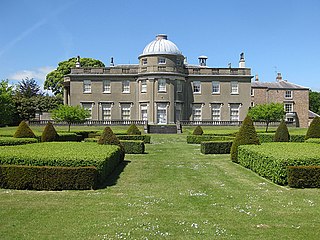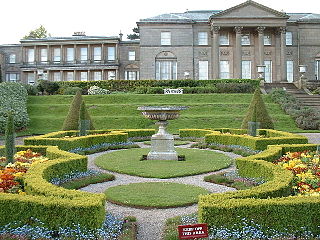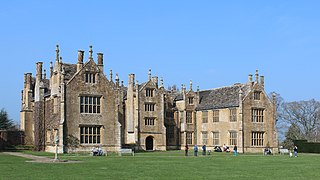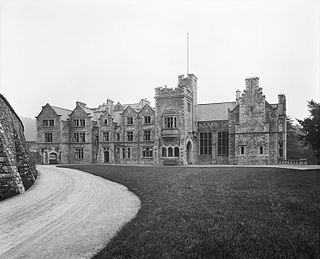This article needs additional citations for verification .(November 2023) |



Levens Hall is a manor house in the Kent valley, near the village of Levens and 5 miles (9 km) south of Kendal in Cumbria, Northern England.
This article needs additional citations for verification .(November 2023) |



Levens Hall is a manor house in the Kent valley, near the village of Levens and 5 miles (9 km) south of Kendal in Cumbria, Northern England.
The first house on the site was a pele tower built by the Redman family in around 1350. Much of the present building dates from the Elizabethan era, when the Bellingham family extended the house. The Bellinghams, who were responsible for the fine panelling and plasterwork in the main rooms, sold the house and estate in 1689 to Colonel James Grahme, or Graham, Keeper of the Privy Purse to King James II. Grahme made a number of additions to the house in the late 17th century. His son Henry Graham was a knight of the shire for Westmorland.
Further additions were made in the early 19th century.
Levens is now owned by the Bagot family and is open to the public. The small collection of steam road vehicles includes several traction engines which are usually steamed on Sundays and Bank Holidays.
In October 2021, the building was one of 142 sites across England to receive part of a £35-million injection into the government's Culture Recovery Fund. [1]
In the 1960s, Levens Hall was reportedly haunted by a Grey Lady. [2]

Levens has a celebrated and large topiary garden, which was first created by the French gardener Guillaume Beaumont, the gardener of King James II and the designer of the grounds at Hampton Court. [3] Beaumont also planned the tree planting in the deer park, now inhabited by black fallow deer and Bagot goats.
The park and gardens laid out by Beaumont between 1689 and 1712 have survived remarkably intact. They have been described as retaining "almost all of the essential elements of the completed scheme as shown on maps of the park and gardens of 1730". [4] In December 2021 the gardens were featured in the BBC series Gardeners' World . [5]
Levens Hall posed as Baskerville Hall for the 2002 BBC production of The Hound of the Baskervilles.

Ulverston is a market town and civil parish in Westmorland and Furness, Cumbria, England. Historically in Lancashire, it lies a few miles south of the Lake District National Park and just north-west of Morecambe Bay, within the Furness Peninsula. Lancaster is 39 miles (63 km) to the east, Barrow-in-Furness 10 miles (16 km) to the south-west and Kendal 25 miles (40 km) to the north-east. In the 2001 census the parish had a population of 11,524, increasing at the 2011 census to 11,678.

Sizergh Castle is a stately home with garden and estate at Helsington in Cumbria, England, about 4 miles (6 km) south of Kendal. Located in historic Westmorland, the castle is a Grade I listed building. While remaining the home of the Hornyold-Strickland family, the castle with its garden and estate is in the care of the National Trust.

Milnthorpe is a village, civil parish, and former market town in Westmorland and Furness, Cumbria, England. It is 7 miles (11 km) south of Kendal. Historically in the county of Westmorland and on the A6, the village contains several old hostelries and hosts a market every Friday. The parish, which includes the village of Ackenthwaite, had a population of 2,199 according to the 2011 Census.

Scampston Hall is a Grade II* listed country house in North Yorkshire, England, with a serpentine park designed by Charles Bridgeman and Capability Brown. It is located on the north side of the A64 Leeds/Scarborough road, 4 miles (6 km) east of Malton, in Scampston village. The name of the village was referred to in various ways in ancient documents as: Scamestun, Skameston, Skameston, and Skampston, and was probably derived from a personal name.

Beetham is a village and civil parish in Westmorland and Furness, Cumbria, England. It is situated on the border with Lancashire, 6 miles (10 km) north of Carnforth. It is part of the Arnside and Silverdale Area of Outstanding Natural Beauty. In the 2001 census the parish had a population of 1,724, increasing at the 2011 census to 1,784.

The Bagot goat is a breed of goat which for several hundred years has lived semi-wild at Blithfield Hall, Staffordshire, England. It is a small goat, with a black head and neck and the remainder of the body white.

Tatton Park is a historic estate in Cheshire, England, north of the town of Knutsford. It contains a mansion, Tatton Hall; a medieval manor house, Tatton Old Hall; Tatton Park Gardens, a farm and a deer park of 2,000 acres (8.1 km2). It is a popular visitor attraction and hosts over a hundred events annually. The estate is owned by the National Trust and is managed under lease by Cheshire East Council. Since 1999, it has hosted North West England's annual Royal Horticultural Society flower show.

Parham House & Gardens is an Elizabethan house and estate in the civil parish of Parham, west of the village of Cootham, and between Storrington and Pulborough, West Sussex, South East England. The estate was originally owned by the Monastery of Westminster and granted to Robert Palmer by King Henry VIII in 1540.

Barrington Court is a Tudor manor house begun around 1538 and completed in the late 1550s, with a vernacular stable court (1675), situated in Barrington, near Ilminster, Somerset, England.

Lowther Castle is a ruined country house in Lowther, Cumbria, England. The estate has belonged to the Lowther family, latterly the earls of Lonsdale, since the Middle Ages. The house was largely built between 1806 and 1814 for William Lowther, 1st Earl of Lonsdale and designed by Robert Smirke in his first major commission. It incorporates fragments of the previous house on the site, which was completed in 1685 for John Lowther, 1st Viscount Lonsdale. It is open to the public and is a grade II* listed building.

Sedgwick is a village and civil parish in Cumbria, England, 4.5 miles (7.2 km) south of Kendal. In the 2001 census the parish had a population of 380, decreasing at the 2011 census to 349.

Graythwaite Hall, in Ulverston, Cumbria in the Lake District of England is the home of the Sandys family.

Dalton Hall is a country house near Burton-in-Kendal in northern England. The hall lies within the county palatine of Lancaster, while Burton lies in the historic county of Westmorland. Both have formed part of Cumbria since 1974.

Henry Graham, of Levens, also spelt Grahme, was an English gentleman, heir to a Westmorland estate, and member of parliament.

Dallam Tower is a grade I listed country house in Beetham parish, near Milnthorpe, South Lakeland, Cumbria, England. It is a member of the Historic Houses Association but is not open to the public except for occasional charity events, visits to the garden through the National Garden Scheme, and as a wedding venue.

James Grahme or Graham (1649–1730) was an English army officer, courtier, politician who sat in the English and British House of Commons between 1685 and 1727. After the Glorious Revolution he was involved for ten years in Jacobite schemes and plots.

Dalemain is a country house around five miles southwest of Penrith in Cumbria, England. It is a Grade I listed building. Dalemain sits within the Lake District National Park.

Workington Hall, sometimes called Curwen Hall, is a ruined building on the Northeast outskirts of the town of Workington in Cumbria. It is a Grade I listed building.

Grizedale Hall was a large country house at Grizedale, Hawkshead, in the Lake District in Cumbria, England. After two earlier Grizedale Halls had preceded, it was built anew in 1905 in the style of Gothic Revival architecture. During World War II it became No 1 Prisoner-of-war camp to hold German officers and was finally pulled down in 1957.
The Lowbridge Estate is a country estate of approximately 2000 acres in the Lake District region of England that was in the continuous ownership of the Fothergill family from 1761. Lowbridge House, the principal house on the estate, was built in the 1830s by Richard Fothergill II (1789–1851) in the cottage orné style. The property was substantially updated and improved in 1889 and again in 2017 to 2019. The property lies between Todd Crag and Bannisdale. Other properties on the Estate include Lowbridge Cottage, Lowbridge Lodge and the Bridge House. The Estate has become a haven for red squirrels with a very active policy of conservation including the extensive planting of red squirrel friendly larch trees and the reintroduction of pine-martins.